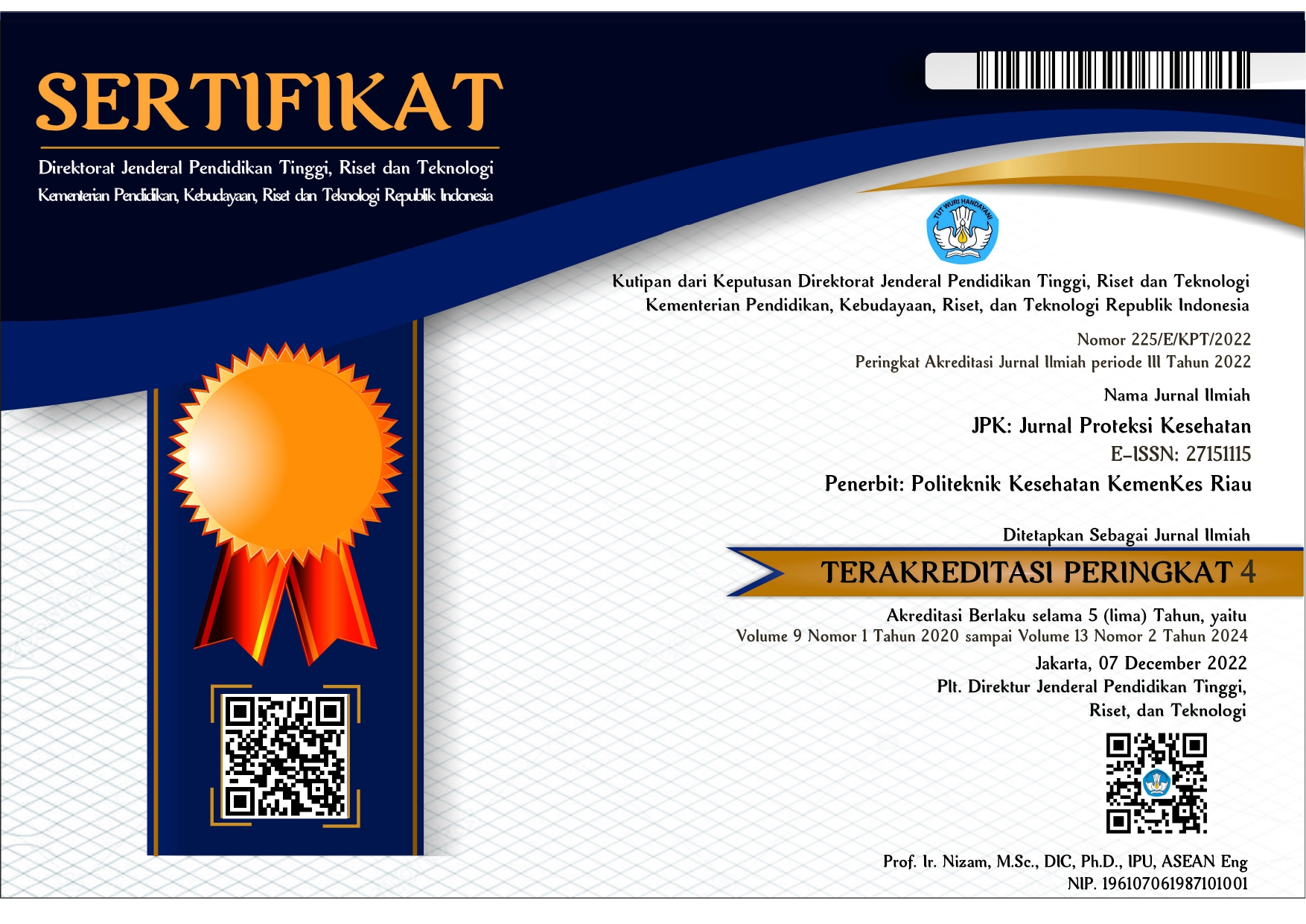Utilization of Patin Fish Bone Waste in Making Snack Bar
Abstract
Fish bone waste can be utilized as catfish bone meal for additional ingredients in making snack bars. This study aims to determine the level of consumer acceptance, as well as to determine the macro nutrients of snack bars with the addition of catfish bone meal. Product manufacturing begins with the manufacture of catfish bone flour and then making 4 snack bar formulations and followed by hedonic test / sensory test. Data were analyzed using the One Way Annova test with a significance level of 0.05 and if there was a significant difference, it was continued with the Duncan test. Calculation of nutritional value was carried out using the Proximate analysis method to determine the content of water, ash, protein, fat and carbohydrates using the SNI 01-2891-1992 method, and calcium analysis using the Inductively Coupled Plasma-Optical Emission Spectrometry (ICP-OES) method. The addition of catfish bone meal did not significantly affect the color, aroma, taste or texture attributes of snack bars (p>0.05). The selected product based on the results of hedonic and content tests is P2 (with the addition of 10 g catfish bone meal) with a slightly brownish beige color, sweet taste, has a distinctive aroma of snack bars with a slightly hard texture. The nutritional content of the selected product is 13.46% moisture content, 3.7% ash content, 20.45% protein, 17.89% fat, 19.95% carbohydrate and 628.52 mg/ 100 g calcium.
References
[2] W. Ayu Rahmawati, F. Choirun Nisa, J. Teknologi Hasil Pertanian, F. Universitas Brawijaya Malang Jl Veteran, and P. Korespondensi, “Fortifikasi Kalsium Cangkang Telur pada Cookies-Rahmawati, dkk,” J. Pangan dan Agroindustri, vol. 3, no. 3, pp. 1050–1061, 2015.
[3] F. Meiyasa and N. Tarigan, “Pemamfaatan Limbah Tulang Ikan Tuna ( Thunnus sp.) Sebagai Sumber Kalsium Dalam Pembuatan Stik Rumput Laut,” J. Teknol. Pertan. Andalas, vol. 24, no. 1, pp. 67–76, 2020.
[4] R. Intan Pratama, I. Rostini, and D. E. Liviawaty, “Rusky Intan Pratama : Karakteristik Biskuit dengan Penambahan Tepung Tulang Ikan Jangilus … Karakteristik Biskuit dengan Penambahan Tepung Tulang Ikan Jangilus (Istiophorus Sp.) Characteristics of Biscuit with Jangilus (Istiophorus sp.) Fish Bone Flour Su.”
[5] N. A. Ladamay and S. S. Yuwono, “Pemanfaatan bahan lokal dalam pembuatan foodbars (kajian rasio tapioka: tepung kacang hijau dan proporsi cmc),” J. Pangan dan Agroindustri, vol. 2, no. 1, pp. 67–78, 2014.
[6] L. N. S. Siregar, N. Harun, and Rahmayuni, “Pemanfaatan Tepung Kacang Merah dan Salak Padang Sidimpuan (Salacca sumatrana R.) dalam Pembuatan SnackBar,” J. Online Mhs. Faperta UR, vol. 4, no. 1, pp. 1–14, 2017.
[7] I. P. Amalia, H. Winarsi, and G. R. Ramadhan, “Pengembangan Brownies Kukus Tepung Talas-Kecambah Kacang Hijau Dan Ubi Ungu Kukus (Talahibu) Untuk Ibu Hamil Kurang Energi Kronik (Kek),” J. Gizi dan Pangan Soedirman, vol. 5, no. 2, p. 48, 2021, doi: 10.20884/1.jgipas.2021.5.2.4281.
[8] Lisda Juniarsy Rahardjo, Asrul Bahar, and Annis Catur Adi, “Pengaruh Kombinasi Kacang Kedelai (Glycine Max) Dan Kacang Tunggak (Vigna Unguiculata (L) Walp.) Yang Diperkaya Biji Nangka (Artocarpus Heterophyllus) Terhadap Daya Terima Dan Kadar Protein Snack Bar ,” Amerta Nutr., vol. 3, no. 1, pp. 71–77, 2019, doi: 10.2473/amnt.v3i1.2019.71-77.
[9] D. Elnovriza, H. Riyadi, R. Rimbawan, E. Damayanthi, and A. Winarto, “Development of fish bars as a high zinc and calcium snack made from bilih fish (Mystacoleuseus padangensis Blkr) flour,” J. Gizi dan Pangan, vol. 14, no. 2, pp. 83–90, 2019, doi: 10.25182/jgp.2019.14.2.83-90.
[10] L. H. Ho, J. Y. H. Tang, S. Mazaitul Akma, H. Mohd Aiman, and A. Roslan, “Development of novel ‘energy’ snack bar by utilizing local Malaysian ingredients,” Int. Food Res. J., vol. 23, no. 5, pp. 2280–2285, 2016.
[11] R. Kasim, L. Ahmad, S. Une, Y. Bait, and S. A. Liputo, “Characterization of Snack Food Bars Made of Nixtamalized Corn Flour and Flour Of Nike Fish for Emergency Food,” Int. J. Agric. Syst., vol. 5, no. 1, p. 33, 2017, doi: 10.20956/ijas.v5i1.1168.
[12] D. Darmawangsyah, J. P. Jamaluddin P, and K. Kadirman, “FORTIFIKASI TEPUNG TULANG IKAN BANDENG (Chanos chanos) DALAM PEMBUATAN KUE KERING,” J. Pendidik. Teknol. Pertan., vol. 2, no. 2, p. 149, 2018, doi: 10.26858/jptp.v2i2.5170.
[13] D. A. Ramadhani and S. Mulyani, “Pengaruh Substitusi Tepung Terigu dengan Tepung Sagu terhadap Tingkat Kesukaan Bolu Kemojo,” J. Prot. Kesehat., vol. 7, no. 2, pp. 68–73, 2018.
[14] D. Lamusu, “Uji Organoleptik Jalangkote Ubi Jalar Ungu ( Ipomoea Batatas L) Sebagai Upaya Diversifikasi Pangan,” J. Pengolah. Pangan, vol. 3, no. 1, pp. 9–15, 2018, doi: 10.31970/pangan.v3i1.7.
[15] D. Zulisyanto, P. H. Riyadi, and U. Amalia, “Pengaruh Lama Pengukursan Adonan terhadap Kualitas Fisik dan Kimia Kerupuk Ikan Lele Dumbo (Clarias gariepinus),” J. Pengolah. dan Bioteknol. Has. Perikan., vol. 5, no. 4, pp. 26–33, 2016, [Online]. Available: http://dspace.unitru.edu.pe/bitstream/handle/UNITRU/10947/Miñano Guevara%2C Karen Anali.pdf?sequence=1&isAllowed=y%0Ahttps://repository.upb.edu.co/bitstream/handle/20.500.11912/3346/DIVERSIDAD DE MACROINVERTEBRADOS ACUÁTICOS Y SU.pdf?sequence=1&isAllowed=.
[16] Y. W. Pertiwi, “Karakteristik Fisik dan Kimia Pada Dagin Ayam Ungkep Kunyit Berdasarkan Perlakuan Kromanon dan Lama Waktu Pengungkepan,” Universitas Katholik Soegijapranata Semarang, 2021.
[17] F. Fitriani, “Pengaruh Penambahan Tiga Jenis Ikan Terhadap Tingkat Kesukaan Dan Kadar Protein Mi Kering,” J. Prot. Kesehat., vol. 7, no. 2, pp. 79–86, 2019, doi: 10.36929/jpk.v7i2.138.
[18] M. Triatmaja, “Pengaruh Substitusi Tepung Ampas Tahu pada Egg Roll terhadap Kadar Protein dan Daya Terima,” Universitas Muhammadiyah Surakarta, 2016.
[19] G. Cormick and J. M. Belizán, “Calcium intake and health,” Nutrients, vol. 11, no. 7, pp. 1–16, 2019, doi: 10.3390/nu11071606.
[20] H. Purnama, R. Hutami, and N. Novidahlia, “Karakteristik Fisikokimia dan Sensori Snack Bar Ampas Tahu dengan Penambahan Kacang Bogor,” J. Pangan Halal, vol. 1, no. 2, pp. 75–82, 2019.












